
Many governments have unveiled plans to achieve net zero carbon emissions that not only seek to reduce emissions, but also aim to be used as driver of economic development. The EU has established the Carbon Border Adjustment Mechanism (CBAM), which is to take effect in 2026. The mechanism requires imported products to be certified with reference to their carbon content before they can enter the EU.
Taiwan has adopted an energy transition policy that aims to achieve net zero emissions by 2050. The policy entails creating a competitive, circular and sustainable transformation strategy to promote the sustainable development of the economy. Taiwan is expected to establish a carbon credit exchange this year, which would gradually establish a supply-and-demand mechanism to enable carbon credit trading. This would complete the overall functions of a carbon-trading market.
With regard to carbon exchanges, Singapore can serve as a model for Taiwan. Singapore started collecting a carbon tax in 2019, making it the first country in Southeast Asia to do so. In 2021, the city-state established the Climate Impact Exchange as a carbon credit trading market.
The chemicals industry, which is one of the sectors that generates high carbon emissions, is also an important pillar of Singapore’s economic development, making the city-state the world’s eighth-largest chemicals exporter. Although Taiwan’s chemicals industry grew 9.9 percent in 2021, it declined 14.7 percent last year due to the effects of a global economic downturn. In comparison, Singapore’s chemicals industry grew 9.2 percent in 2021, but it outperformed Taiwan last year by shrinking just 5.5 percent.
This shows that although a carbon tax increases industrial operating costs, the mechanism of an exchange can still help accelerate industrial transformation by allowing enterprises that implement carbon reduction to gain greater benefits.
Kaohsiung produces about one-fifth of Taiwan’s total carbon emissions, or about 57.37 million tonnes as of last year, making it the country’s biggest emitter. Among the high-carbon-emission industries, Kaohsiung is the production center of chemical materials, petroleum and coal products, and base metals. Kaohsiung accounts for 27 percent of Taiwan’s output of chemical materials and 41 percent of its base metals, making it the nation’s biggest producer in both categories. It ranks second in the petroleum and coal products sector, accounting for 32 percent of Taiwan’s total output.
It also accounts for more than 20 percent of Taiwan’s total production of vehicles and vehicle parts, as well as the waste removal, treatment and resource recovery sector.
Kaohsiung’s industrial carbon reduction targets are expected to contribute more than 10 million tonnes of carbon reduction by 2030. From the perspective of supply and demand in the carbon-trading market, Kaohsiung is the largest buyer and seller in Taiwan. Coupled with the advantages of the Port of Kaohsiung and the industrial chain, if there comes a time when Taiwan requires imported goods to obtain carbon reduction quotas, i.e. a Taiwanese version of the CBAM, then goods arriving at the Port of Kaohsiung would generate demand for carbon trading. These factors would give Kaohsiung a geographical advantage as the location for establishing a carbon-trading exchange.
A carbon exchange would not only drive the transformation of local high-carbon-emission industries and provide more effective solutions, but also be one of the most cost-effective ways for Taiwan to achieve its carbon reduction goals.
Lee Shun-fa is an associate professor in Tamkang University’s Department of Industrial Economics.
Translated by Julian Clegg
Comments will be moderated. Keep comments relevant to the article. Remarks containing abusive and obscene language, personal attacks of any kind or promotion will be removed and the user banned. Final decision will be at the discretion of the Taipei Times.






